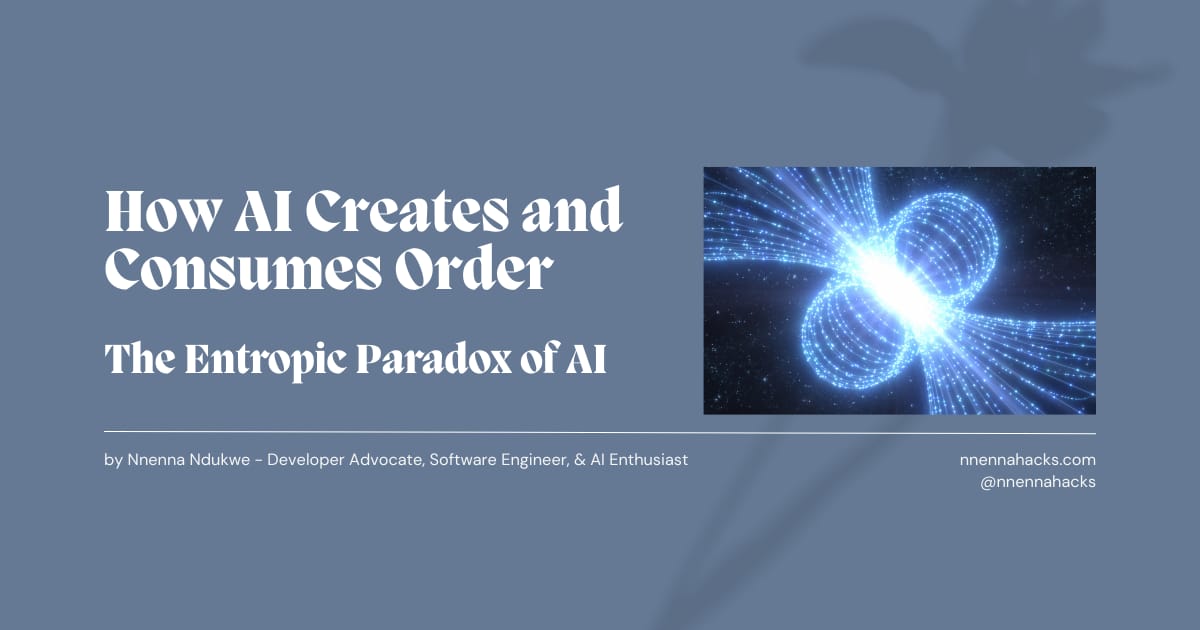- nnenna hacks
- Posts
- AI and Entropy: Why the Most Advanced Technology Is Also the Most Chaotic
AI and Entropy: Why the Most Advanced Technology Is Also the Most Chaotic
A thought-provoking exploration of how AI simultaneously reduces and increases entropy across information, energy, and society — and what that means for our future.

Let’s Begin with Entropy
In thermodynamics, entropy measures disorder within a system. The second law of thermodynamics states that the total entropy of an isolated system always increases over time. Systems naturally move from order to disorder, from predictability to unpredictability. This principle governs stars, lab experiments, and increasingly, our digital world.
What Is Entropy in Technology?
Since our earliest inventions, technology has been humanity's rebellion against entropy. From the wheel to the internet, we create systems to impose order on chaos. But as author Jeremy Rifkin noted in his book Entropy, each wave of technological progress introduces new, often invisible forms of disorder.
Every innovation solves old problems but creates new ones:
The Industrial Revolution brought production efficiency, but also pollution
The Information Age enhanced connectivity, but birthed information overload
How AI Fights Entropy (But Also Fuels It)
AI might be the most powerful entropy-reducing tool we’ve built — and also the most entropic.
Order from Chaos: How AI Reduces Entropy
Large Language Models (LLMs): Organize massive text corpora into useful responses
Computer Vision: Extract patterns from noisy image data
Recommendation Engines: Predict user preferences from billions of signals
Generative AI: Create structured output from unstructured data
These systems impose clarity, structure, and pattern onto overwhelming complexity.
Chaos from Order: How AI Introduces Entropy
Information Entropy: Provenance becomes unclear in AI-generated data
Trust Entropy: Misuse of terms like "open-source" muddies industry transparency
Social Entropy: AI reflects and sometimes amplifies societal biases
Control Entropy: Democratized access brings unpredictable applications
Energy Entropy: Rising model complexity increases heat and environmental impact
The Rifkin Warning
Rifkin argued that while technology creates local order, it contributes to global entropy. AI follows this pattern: concentrated benefits, distributed costs.
According to the 2024 State of DevOps Report:
81% of companies are shifting resources into AI
$1 trillion projected investment over five years
This centralization of resources and attention itself creates systemic disorder elsewhere.
Energy Footprint
AI will drive a 160% increase in data center demand by 2030
A single model may consume the energy of 1,000+ US homes
Adoption Costs (Forms of Entropy)
Productivity entropy: Temporary disruption during implementation
Expertise entropy: Skills gaps and labor shifts
Societal entropy: One-third of experts believe AI will harm society
Strategies for Responsible AI Entropy Management
1. Energy-Efficient AI Systems
Use specialized chips and quantum computing for reduced consumption
2. Data Provenance Tools
Track lineage and authenticity of training and output data
3. Entropy-Aware Algorithms
Design models that optimize for both performance and energy/resource cost
4. Socio-Technical Design
Consider the broader social system in which AI operates
5. Interdisciplinary Development
Include ethicists, social scientists, and marginalized voices
6. Sustainable AI Ecosystems
Prioritize recyclability, energy metrics, and "Green AI" principles
The Entropy Balance Sheet
As technologists, we must ask:
Does this reduce or increase information traceability?
Does it clarify or confuse core concepts?
Does it distribute or concentrate power?
Does the energy cost outweigh the efficiency gain?
Does it introduce new risks to social or financial systems?
We need both quantitative and qualitative measures to assess AI’s true entropy impact.
What AGI Means for the Entropy Equation
Artificial General Intelligence (AGI) brings extreme entropy potential. Misalignment risks could introduce unparalleled unpredictability — the ultimate form of disorder. This is not sci-fi; it’s a widely acknowledged concern in the AI research community.
Conclusion: Building with Entropy in Mind
Entropy is not the enemy, it's a law. The question is how we work with it. AI systems that respect entropic trade-offs will be:
More trustworthy
More sustainable
More aligned with human goals
The best AI is not the most powerful. It’s the most responsible.
Reply